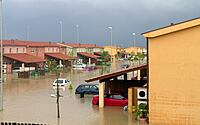5 Tips for Dealing with Water Damage After a Storm
A storm can have devastating effects on your property. Structural damage is among the top damages a storm may cause. You may experience cracks in the foundation, leaking roofs, and a flooded basement. If your home doesn’t have a good stormwater management system, your property and lawn could be at risk.
Wet soil conditions, primarily against the foundation, make maintaining your garden and lawn beds challenging. Stormwater can affect your property by lowering its value. Handling the stormwater issue promptly can help salvage your property and everything in it. Here are five tips for dealing with water damage after a storm.
1. Hire a water damage restoration service
A water damage restoration service is crucial to ensuring quick restoration. The service responds immediately and within a short time, cleans up the water, dries and disinfects your space, and also makes the necessary repairs. Calling them sooner reduces costs and losses. Mold growth is a significant challenge that stormwater brings. Most molds are irritating or toxic allergens, so removing them yourself can be risky.
Hiring Your Trustworthy Damage Restoration Experts ensures safe mold remediation. They can also give you professional advice on whether your appliances, carpet, furniture, or drywall are damaged or may be reused.
2. Ensure your safety
Water is a good electricity conductor, which risks your and your loved ones’ safety if the normal electric flow continues. Consider disabling all electricity sources in the affected parts. If the circuit breaker panel is easily accessible, shut off every circuit in each affected area. Unplug all electrical devices and contain all your loved ones and pets in a safe place. Use protective gear, including gloves and rubber boots, when entering your property.
3. Notify your insurance company
Calling your insurance company to notify them of the water damage affecting your home should be the first thing you do before beginning any repairs. This allows them a chance to inspect the property. They may cry foul if you start repairing your property before informing them. However, you should read your homeowners insurance policy to determine what you’re covered for since not all policies cover water damage. Take videos and photos as proof of the water damage to show the insurance company, and only replace or remove damaged items with the insurer’s approval.
4. Begin water damage repairs immediately
Water damage causes severe damage. This is why you should start the restoration process immediately to prevent your home’s structural and mold damage and avoid costly issues. If you can’t afford to hire a water damage restoration service, get other family members or friends to help because the damage can be extensive. Also, ensure you have the right tools and equipment for quick restoration. Note that you might have to remove your insulation, drywall, and flooring to avoid mildew and mold from spreading across the entire property. You might have to clean, throw away or dry out furniture based on the water damage level.
5. Ensure proper ventilation
Proper ventilation prevents secondary water damage, eventually causing mold growth. Using fans and high-capacity humidifiers or opening windows and doors can help keep your home dry, promoting a healthy, mold-free environment and reducing further damage.
Endnote
Water damage can have devastating effects on your property. Use these tips to deal with water damage after a storm.
- by Matt Watts

